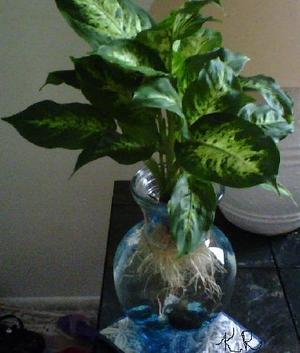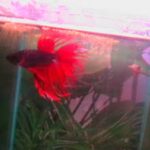Male betas are some of the most colorful freshwater aquarium fish, and amazingly they are able to survive without an aerator in a smaller than usual tank. Unfortunately the male beta, otherwise known as a Siamese fighting fish, is aggressive and can’t be placed in a tank with another male beta or other less aggressive fish. They do however make fantastic pets for those who prefer something aquatic that’s very easy to care for. The male beta can survive in less than ideal conditions, and in the wild these colorful fish thrive in brackish water.
Beta fish are often seen in tiny containers in discount stores and pet stores without much room to move. If you’d like a colorful male beta, instead of keeping your fish in a tiny container or an ordinary bowl, give him room to move, and consider making a beautiful beta bowl. A beta bowl consists of a large clear glass vase with a wide mouth, pretty stones or marbles that line the bottom, a live philodendron plant, and a clear plastic support. A beta bowl makes a fantastic centerpiece, and it’s definitely a great conversation piece.
Precautionary Note
If your tap water contains chlorine, allow the water to sit for at least 24 hours to allow it to evaporate before putting the fish in the bowl. Chlorine-free water is better for the plant as well as the fish.
Necessary Supplies
Visit the craft aisle of your local discount store, or search online for a large clear glass vase in which to house your beta, decorative glass marbles or polished stones, and a philodendron in a three or four-inch pot. Also, look for a clear plastic insert that sits at the top of the bowl to support the plant, and don’t forget to purchase food for your fish. Some people think that betas can survive by eating the roots of the plant, but this isn’t true. Like all other living creatures, betas must be fed regularly in order to survive.
Plant Preparation
Prepare the philodendron by knocking off as much of the dirt and organic material as possible from the roots, and rinse them under room temperature water until no more dirt remains. If the roots are extremely long, trim them with a pair of scissors. Once the roots are in the water they will quickly grow again, and they will require future trimmings.
Assembly
Begin by rinsing the beta bowl until no more dust or debris remains. Also, rinse the plastic insert and the clear glass marbles or polished stones to ensure they are clean. Next, fill the beta bowl with room temperature water about four inches from the rim, place the roots of the plant within the plastic support, and place the plant on top of the bowl with the majority of the roots below the top of the water. Lastly, lift up the plant, and gently release the fish into the bowl. The water level should cover the roots of the plant, but there should be enough surface space to provide adequate oxygen to the beta.
Beta Bowl Care
As previously mentioned, feed your beta pellets or flakes especially for betas on a daily basis. Follow product label instructions for best results. Beta Bites are a good choice, and this product can be found at Wal-Mart or online.
Remove approximately 10% of the water in your beta bowl once a week, and replace it with chlorine-free water after cleaning the sides with a long handled brush. Place your beta bowl out of direct sunlight to protect the beta and to keep algae from building up on the sides too quickly. With proper care your beta should live a long and carefree life.





